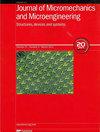压力范围宽的组合式 MEMS 热真空传感器
IF 2.1
4区 工程技术
Q2 ENGINEERING, ELECTRICAL & ELECTRONIC
引用次数: 0
摘要
MEMS 热真空传感器已广泛应用于许多学术和工业领域,而压力范围是 MEMS 热真空传感器的一项关键性能。为了扩大压力范围,本研究提出了一种由两个二极管型 MEMS 热真空传感器串联组成的组合式 MEMS 热真空传感器。这两个二极管型传感器的敏感区域和敏感区域与散热器之间的距离各不相同,它们对压力的响应分别为 3.0 × 10-3 至 3 × 104 Pa 和 1.7 × 10-2 至 4.4 × 105 Pa。通过将它们串联起来,组合传感器的压力范围可达 1.3 × 10-3 至 6.9 × 105 Pa,而无需任何额外的控制电路。此外,它还具有 400 × 300 μm2 的相对较小尺寸。这表明组合式 MEMS 热真空传感器具有压力范围宽、灵敏度高和体积小的特点。本文章由计算机程序翻译,如有差异,请以英文原文为准。
A combined MEMS thermal vacuum sensor with a wide pressure range
MEMS thermal vacuum sensors have been widely applied in many academic and industry fields, and pressure range is a key performance of MEMS thermal vacuum sensors. To extend the pressure range, a combined MEMS thermal vacuum sensor that consists of two diode-type MEMS thermal vacuum sensors in series is proposed in this work. The two diode-type sensors are designed to have different areas of sensitive region and distances between sensitive region and heat sink, and their responses to the pressure are from 3.0 × 10−3 to 3 × 104 Pa and from 1.7 × 10−2 to 4.4 × 105 Pa, respectively. By series-connecting them, the combined sensor achieves a pressure range of 1.3 × 10−3 to 6.9 × 105 Pa without any additional control circuit. In addition, it possesses a relatively small size of 400 × 300 μ m2. These indicate that the combined MEMS thermal vacuum sensor has the characteristics of wide pressure range, high sensitivity and small size.
求助全文
通过发布文献求助,成功后即可免费获取论文全文。
去求助
来源期刊

Journal of Micromechanics and Microengineering
工程技术-材料科学:综合
CiteScore
4.50
自引率
4.30%
发文量
136
审稿时长
2.8 months
期刊介绍:
Journal of Micromechanics and Microengineering (JMM) primarily covers experimental work, however relevant modelling papers are considered where supported by experimental data.
The journal is focussed on all aspects of:
-nano- and micro- mechanical systems
-nano- and micro- electomechanical systems
-nano- and micro- electrical and mechatronic systems
-nano- and micro- engineering
-nano- and micro- scale science
Please note that we do not publish materials papers with no obvious application or link to nano- or micro-engineering.
Below are some examples of the topics that are included within the scope of the journal:
-MEMS and NEMS:
Including sensors, optical MEMS/NEMS, RF MEMS/NEMS, etc.
-Fabrication techniques and manufacturing:
Including micromachining, etching, lithography, deposition, patterning, self-assembly, 3d printing, inkjet printing.
-Packaging and Integration technologies.
-Materials, testing, and reliability.
-Micro- and nano-fluidics:
Including optofluidics, acoustofluidics, droplets, microreactors, organ-on-a-chip.
-Lab-on-a-chip and micro- and nano-total analysis systems.
-Biomedical systems and devices:
Including bio MEMS, biosensors, assays, organ-on-a-chip, drug delivery, cells, biointerfaces.
-Energy and power:
Including power MEMS/NEMS, energy harvesters, actuators, microbatteries.
-Electronics:
Including flexible electronics, wearable electronics, interface electronics.
-Optical systems.
-Robotics.
 求助内容:
求助内容: 应助结果提醒方式:
应助结果提醒方式:


